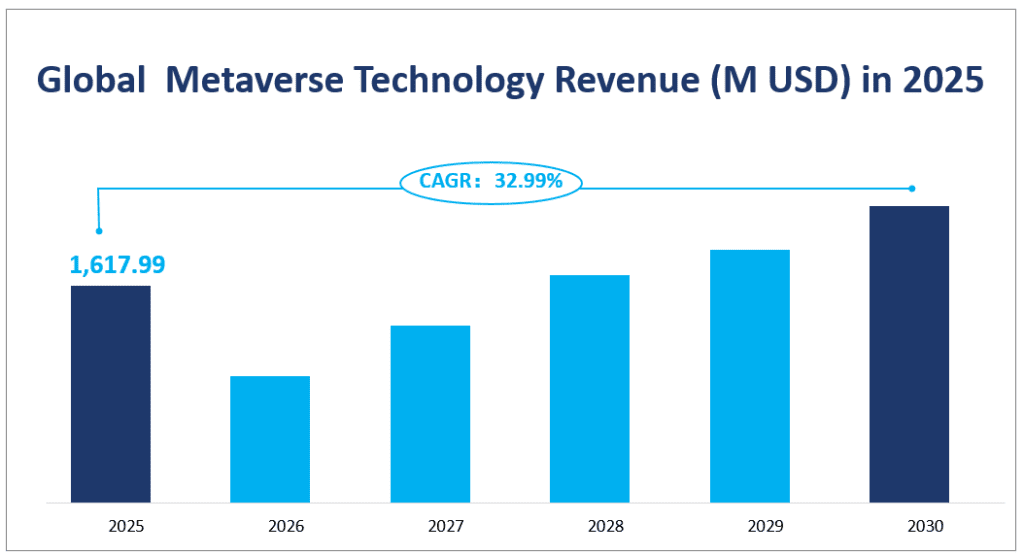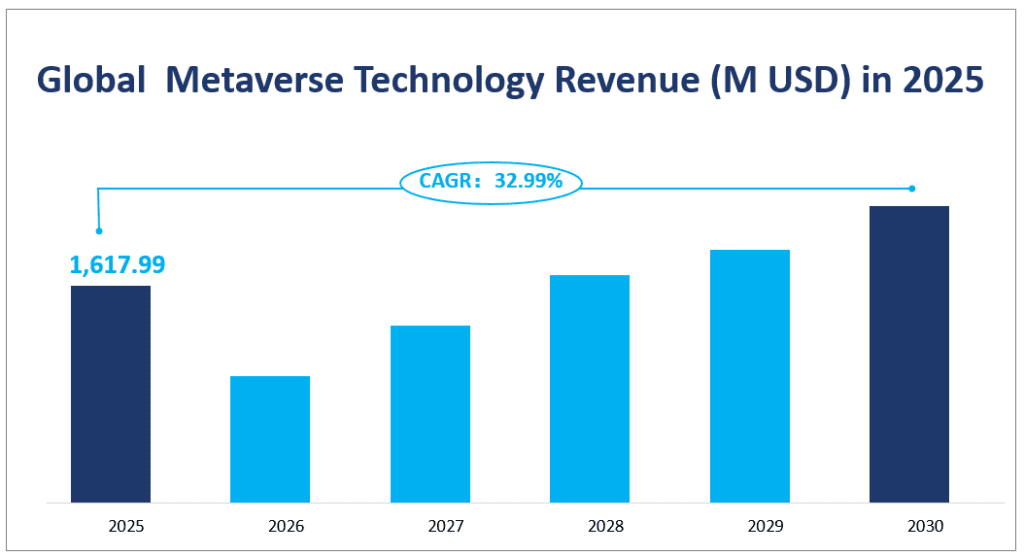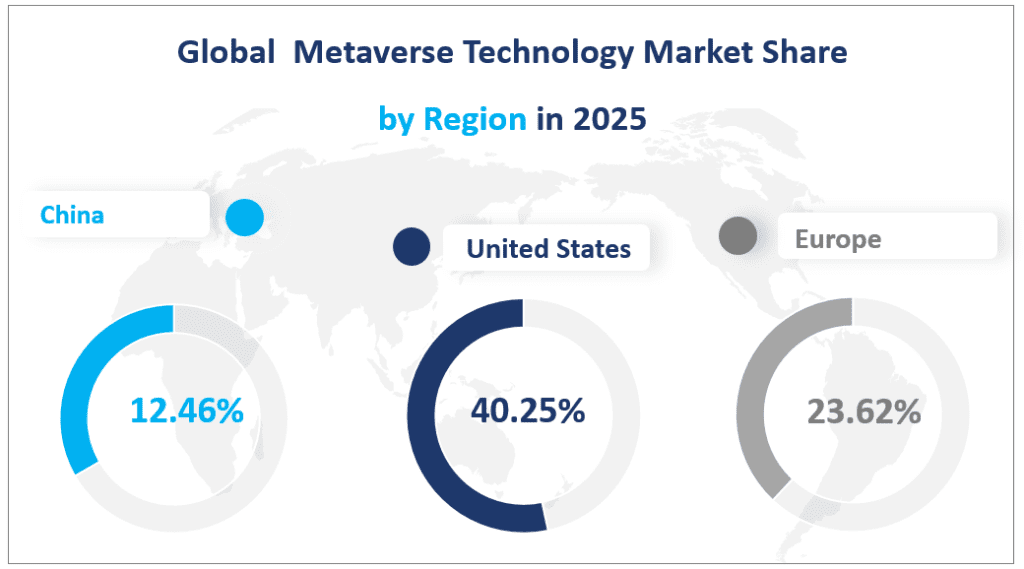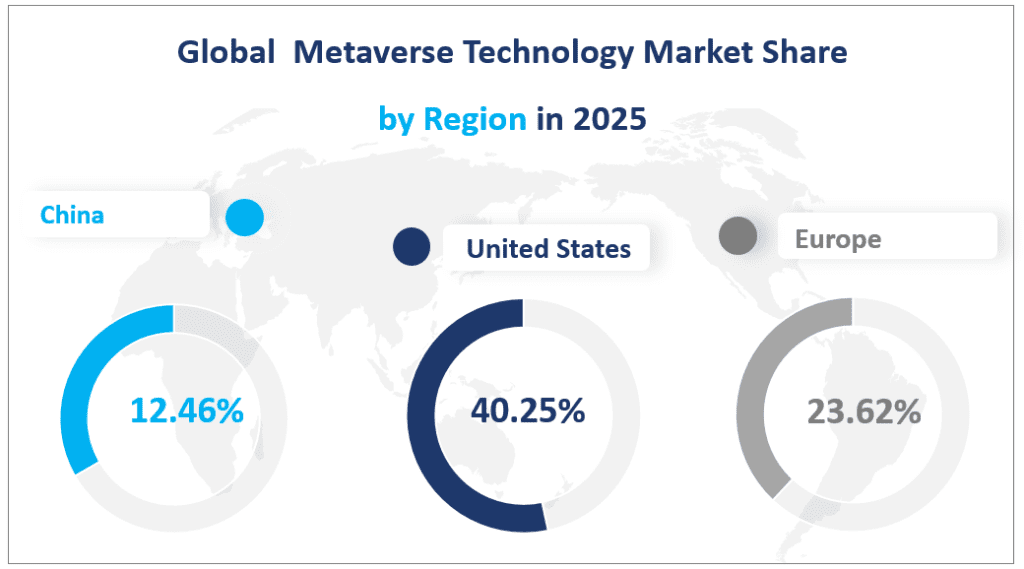1. Global Metaverse Technology Market Definition
The global Metaverse Technology market is poised for significant growth, with revenue projected to reach $1,617.99 million in 2025 with a CAGR of 32.99% from 2025 to 2030.
The Metaverse is a collective virtual shared space created by the fusion of virtual, augmented, and digital realities. It represents a convergence of multiple advanced technologies, including virtual reality (VR), augmented reality (AR), the Internet of Things (IoT), artificial intelligence (AI), and non-fungible tokens (NFTs). This immersive environment allows users to interact in a virtual world that mirrors real-life experiences, enabling activities such as gaming, socializing, conducting business, and even attending virtual conferences. The Metaverse is not just a technological advancement but a paradigm shift in how we perceive and interact with digital spaces.
Global Metaverse Technology Revenue (M USD) in 2025


2. Driving Factors of Metaverse Technology Market
Technological Advancements: Rapid advancements in VR, AR, AI, and IoT technologies are enabling the development of more sophisticated and realistic virtual environments. These advancements are crucial in enhancing the user experience and expanding the potential applications of Metaverse Technology.
Growth in Digital Asset Transactions: The rise of cryptocurrencies and NFTs has created a new economy within the Metaverse. Users can buy, sell, and trade digital assets, creating a vibrant ecosystem that drives engagement and investment in the Metaverse.
Corporate Investments and Strategic Partnerships: Major tech companies like Microsoft, Meta (formerly Facebook), and Tencent are heavily investing in Metaverse initiatives. These investments are aimed at developing infrastructure, acquiring key technologies, and creating content that will fuel the growth of the Metaverse.
3. Limiting Factors of Metaverse Technology Market
Technical Challenges: Despite advancements, the Metaverse still faces significant technical challenges. Issues such as latency, bandwidth limitations, and the need for high-performance hardware can hinder the widespread adoption of immersive virtual experiences.
Cybersecurity and Privacy Concerns: The Metaverse involves the collection and processing of vast amounts of user data, raising concerns about privacy and security. Cyberattacks, data breaches, and the misuse of personal information are potential risks that need to be addressed to ensure user trust.
High Entry Barriers: The development of Metaverse technologies requires substantial financial investment, technical expertise, and access to advanced hardware and software. These barriers can limit the entry of new players and slow down market expansion.
Regulatory and Legal Issues: The regulatory landscape for digital assets and virtual environments is still evolving. Unclear regulations and legal frameworks can create uncertainties for businesses operating in the Metaverse.
User Adoption and Awareness: While interest in the Metaverse is growing, widespread user adoption remains a challenge. Many consumers are still unaware of the potential benefits of Metaverse Technology, and there is a need for increased awareness and education to drive broader acceptance.
4. Metaverse Technology Market Segment
Product Types
In 2025, Desktop Metaverse Technology holds the largest market share, accounting for approximately 52.84% of the total market revenue. This dominance is attributed to the advanced capabilities and infrastructure required for immersive virtual experiences, making desktop platforms a preferred choice for high-end applications such as virtual reality gaming, content creation, and industrial simulations.
On the other hand, Mobile Metaverse Technology is the fastest-growing segment, with a slightly higher compound annual growth rate compared to desktop. The mobile segment benefits from the widespread adoption of smartphones and tablets, which offer accessibility and convenience for users to engage with the Metaverse. This growth is driven by the increasing popularity of mobile VR and AR applications, as well as the development of more powerful mobile processors that can support advanced Metaverse experiences.
Despite the higher growth rate of mobile, desktop platforms are expected to maintain a significant market share due to their superior performance and capabilities. However, the mobile segment’s rapid expansion indicates a growing trend towards more accessible and portable Metaverse experiences, which could potentially bridge the gap in market share over time.
Market Value and Share by Type
| Type | Market Value (Million USD) in 2025 | Market Share in 2025 |
| Desktop | 85,494 | 52.84% |
| Mobile | 76,304 | 47.16% |
Market by Applications
Among all applications, Game holds the largest market share in 2025, accounting for approximately 33.68% of the total market revenue. The gaming sector has been a significant driver of Metaverse Technology, with virtual reality (VR) and augmented reality (AR) enhancing the immersive experience for players. The continuous evolution of gaming platforms and the increasing popularity of multiplayer online games contribute to the substantial revenue generated by this application.
The Industrial application is the fastest-growing segment. This growth is driven by the increasing adoption of Metaverse Technology in industrial operations, such as remote assistance, virtual training, and simulation. The ability to create realistic and interactive virtual environments for industrial applications enhances efficiency, reduces costs, and improves safety, making it a highly attractive solution for industries.
Other notable applications include Education and Entertainment and Media, both of which are experiencing significant growth with market shares of 31.75% and 31.70%, respectively. The education sector benefits from the immersive learning experiences offered by the Metaverse, while the entertainment and media industry leverages the technology for virtual concerts, movies, and interactive content.
The Metaverse Technology market is characterized by diverse product types and applications, each contributing uniquely to its growth. Desktop platforms currently dominate the market, but mobile technologies are rapidly catching up, driven by their accessibility and convenience. In terms of applications, gaming remains the largest segment, while industrial applications are the fastest-growing, highlighting the potential for Metaverse Technology to revolutionize various sectors. As the market continues to evolve, stakeholders must adapt to these trends to capitalize on the opportunities presented by this transformative technology.
Market Value and Share by Application
| Application | Consumption Value (M USD) in 2025 | Market Share in 2025 |
| Game | 54,494 | 33.68% |
| Social | 27,926 | 17.26% |
| Conference | 6,957 | 4.30% |
| Content Creation | 14,083 | 8.70% |
| Education | 15,419 | 9.53% |
| Industrial | 12,092 | 7.47% |
| Entertainment and Media | 19,869 | 12.28% |
| Others | 10,958 | 6.77% |
5. Regional Metaverse Technology Market
The United States holds the largest market value in 2025, accounting for approximately 40.25% of the total global market. This dominance is attributed to the presence of major tech companies, advanced infrastructure, and a high adoption rate of digital technologies. The United States is a hub for innovation in the Metaverse, with significant investments in VR, AR, and AI technologies. Companies like Microsoft and Meta (formerly Facebook) are at the forefront of developing and deploying Metaverse solutions, driving the market’s growth.
The Middle East and Africa region is the fastest-growing segment, with a projected compound annual growth rate (CAGR) of 31.40% from 2025 to 2030. This growth is driven by increasing digital adoption, rising disposable incomes, and a growing interest in immersive technologies. The region’s emerging markets, such as the UAE and Saudi Arabia, are investing heavily in digital infrastructure, making them prime candidates for rapid expansion in the Metaverse Technology market.
Europe’s market is driven by strong regulatory frameworks and a focus on digital transformation with a market value of $38212 million in 2025. Countries like Germany, France, and the UK are leading the charge, with significant investments in VR and AR technologies.
China’s market is growing rapidly, driven by government support and a large consumer base with a market revenue of $20156 in 2025. The country’s focus on IoT and AI technologies is creating a strong foundation for Metaverse applications.
Latin America’s market is growing with a market value of $6189 million in 2025, driven by increasing digital adoption and a focus on entertainment and social applications. Brazil and Mexico are leading the charge, with significant investments in digital infrastructure.
The region’s market is growing rapidly with a market size of 5362 $million in 2025, driven by increasing digital adoption and a focus on entertainment and education. The UAE and Saudi Arabia are leading the charge, with significant investments in digital infrastructure.
Global Metaverse Technology Market Share by Region in 2025


6. Top 3 Companies in the Metaverse Technology Market
Company Introduction and Business Overview: Microsoft is a global technology leader with a diverse portfolio of products and services. Founded in 1975, the company has a strong presence in software, cloud computing, and hardware. Microsoft’s focus on innovation and strategic partnerships has positioned it as a key player in the Metaverse Technology market.
Products Offered: Microsoft offers a range of products and services that support the Metaverse, including the HoloLens, Azure cloud services, and the Mesh platform. These products enable immersive experiences and seamless integration of virtual and real-world environments.
Company Introduction and Business Overview: Meta, formerly known as Facebook, is a leading social media and technology company. Founded in 2004, Meta has expanded its focus to include virtual reality and augmented reality technologies. The company’s vision is to build the Metaverse as the next evolution of social interaction and digital experiences.
Products Offered: Meta offers a range of products, including the Oculus VR headsets, Meta Quest, and various AR and VR applications. These products enable users to engage in immersive experiences and interact in virtual environments.
Company Introduction and Business Overview: Roblox Corporation is a leading platform for user-generated content and immersive experiences. Founded in 2004, Roblox offers a platform where users can create and share their virtual worlds and games. The company’s focus on community and creativity has positioned it as a key player in the Metaverse Technology market.
Products Offered: Roblox offers a range of products, including the Roblox Studio, which enables users to create their own virtual experiences, and the Roblox platform, which allows users to explore and interact in virtual worlds created by others.
Major Players
| Company Name | Sales Region | Competitors |
| Microsoft | Worldwide | Meta (formerly Facebook), Roblox Corporation |
| Meta (formerly Facebook) | Worldwide | Microsoft, Roblox Corporation |
| Roblox Corporation | Worldwide | Microsoft, Meta (formerly Facebook) |
| Tencent | Worldwide | NetEase, Baidu, ByteDance |
| Unity | Mainly in North America, Europe, Asia | Nvidia, Autodesk |
| Nvidia | Mainly in North America, Europe, Asia | Unity, Autodesk |
| Autodesk | Worldwide | Unity, Nvidia |
| NetEase | Mainly in Asia, North America, Europe | Tencent, Baidu, ByteDance |
| Nexon | Worldwide | Baidu, ByteDance |
| Baidu | Mainly in Asia, North America | Tencent, NetEase |
| ByteDance | Mainly in Asia, America, Europe | Tencent, NetEase |
| Epic Games | Mainly in North America, Europe, Asia | Fastly, Magic Leap |
| Fastly | Mainly in North America, Europe, Asia | Epic Games, Magic Leap |
| Magic Leap | Worldwide | Epic Games, Fastly |
1 Metaverse Technology Market Overview
1.1 Product Overview and Scope of Metaverse Technology
1.2 Metaverse Technology Market Segment by Type
1.2.1 Global Metaverse Technology Market Revenue and CAGR (%) Comparison by Type (2021-2031)
1.3 Global Metaverse Technology Market Segment by Application
1.3.1 Metaverse Technology Market Consumption (Value) Comparison by Application (2021-2031)
1.4 Global Metaverse Technology Market, Region Wise (2021-2031)
1.4.1 Global Metaverse Technology Market Size (Value) and CAGR (%) Comparison by Region (2021-2031)
1.4.2 United States Metaverse Technology Market Status and Prospect (2021-2031)
1.4.3 Europe Metaverse Technology Market Status and Prospect (2021-2031)
1.4.4 China Metaverse Technology Market Status and Prospect (2021-2031)
1.4.5 Japan Metaverse Technology Market Status and Prospect (2021-2031)
1.4.6 India Metaverse Technology Market Status and Prospect (2021-2031)
1.4.7 Southeast Asia Metaverse Technology Market Status and Prospect (2021-2031)
1.4.8 Latin America Metaverse Technology Market Status and Prospect (2021-2031)
1.4.9 Middle East and Africa Metaverse Technology Market Status and Prospect (2021-2031)
1.5 Global Market Size of Metaverse Technology (2021-2031)
1.6 Global Macroeconomic Analysis
1.7 The impact of the Russia-Ukraine war on the Metaverse Technology Market
2 Industry Outlook
2.1 Metaverse Technology Industry Technology Status and Trends
2.2 Industry Entry Barriers
2.2.1 Analysis of Financial Barriers
2.2.2 Analysis of Technical Barriers
2.2.3 Analysis of Talent Barriers
2.2.4 Analysis of Brand Barrier
2.3 Metaverse Technology Market Drivers Analysis
2.4 Metaverse Technology Market Challenges Analysis
2.5 Emerging Market Trends
2.6 Consumer Preference Analysis
2.7 Metaverse Technology Industry Development Trends under COVID-19 Outbreak
2.7.1 Global COVID-19 Status Overview
2.7.2 Influence of COVID-19 Outbreak on Metaverse Technology Industry Development
3 Global Metaverse Technology Market Landscape by Player
3.1 Global Metaverse Technology Revenue and Market Share by Player (2021-2026)
3.2 Metaverse Technology Market Competitive Situation and Trends
3.2.1 Metaverse Technology Market Concentration Rate
3.2.2 Metaverse Technology Market Share of Top 3 and Top 6 Players
3.2.3 Mergers & Acquisitions, Expansion
4 Global Metaverse Technology Revenue, Region Wise (2021-2026)
4.1 Global Metaverse Technology Revenue and Market Share, Region Wise (2021-2026)
4.2 Global Metaverse Technology Value and Gross Margin (2021-2026)
4.3 United States Metaverse Technology Value and Gross Margin (2021-2026)
4.3.1 United States Metaverse Technology Market Under COVID-19
4.4 Europe Metaverse Technology Value and Gross Margin (2021-2026)
4.4.1 Europe Metaverse Technology Market Under COVID-19
4.5 China Metaverse Technology Value and Gross Margin (2021-2026)
4.5.1 China Metaverse Technology Market Under COVID-19
4.6 Japan Metaverse Technology Value and Gross Margin (2021-2026)
4.6.1 Japan Metaverse Technology Market Under COVID-19
4.7 India Metaverse Technology Value and Gross Margin (2021-2026)
4.7.1 India Metaverse Technology Market Under COVID-19
4.8 Southeast Asia Metaverse Technology Value and Gross Margin (2021-2026)
4.8.1 Southeast Asia Metaverse Technology Market Under COVID-19
4.9 Latin America Metaverse Technology Value and Gross Margin (2021-2026)
4.9.1 Latin America Metaverse Technology Market Under COVID-19
4.10 Middle East and Africa Metaverse Technology Value and Gross Margin (2021-2026)
4.10.1 Middle East and Africa Metaverse Technology Market Under COVID-19
5 Global Metaverse Technology Revenue by Type
5.1 Global Metaverse Technology Revenue and Market Share by Type
5.2 Global Metaverse Technology Revenue and Growth Rate by Type (2021-2026)
5.2.1 Global Metaverse Technology Revenue and Growth Rate of Desktop (2021-2026)
5.2.2 Global Metaverse Technology Revenue Growth Rate of Mobile (2021-2026)
6 Global Metaverse Technology Market Analysis by Application
6.1 Global Metaverse Technology Consumption Value and Market Share by Application (2021-2026)
6.2 Global Metaverse Technology Consumption Value and Growth Rate by Application (2021-2026)
6.2.1 Global Metaverse Technology Consumption Value and Growth Rate of Game (2021-2026)
6.2.2 Global Metaverse Technology Consumption Value and Growth Rate of Social (2021-2026)
6.2.3 Global Metaverse Technology Consumption Value and Growth Rate of Conference (2021-2026)
6.2.4 Global Metaverse Technology Consumption Value and Growth Rate of Content Creation (2021-2026)
6.2.5 Global Metaverse Technology Consumption Value and Growth Rate of Education (2021-2026)
6.2.6 Global Metaverse Technology Consumption Value and Growth Rate of Industrial (2021-2026)
6.2.7 Global Metaverse Technology Consumption Value and Growth Rate of Entertainment and Media (2021-2026)
6.2.8 Global Metaverse Technology Consumption Value and Growth Rate of Others (2021-2026)
7 Global Metaverse Technology Market Forecast (2026-2031)
7.1 Global Metaverse Technology Revenue Forecast (2026-2031)
7.2 Global Metaverse Technology Revenue Forecast, Region Wise (2026-2031)
7.2.1 United States Metaverse Technology Revenue Forecast (2026-2031)
7.2.2 Europe Metaverse Technology Revenue Forecast (2026-2031)
7.2.3 China Metaverse Technology Revenue Forecast (2026-2031)
7.2.4 Japan Metaverse Technology Revenue Forecast (2026-2031)
7.2.5 India Metaverse Technology Revenue Forecast (2026-2031)
7.2.6 Southeast Asia Metaverse Technology Revenue Forecast (2026-2031)
7.2.7 Latin America Metaverse Technology Revenue Forecast (2026-2031)
7.2.8 Middle East and Africa Metaverse Technology Revenue Forecast (2026-2031)
7.3 Global Metaverse Technology Revenue Forecast by Type (2026-2031)
7.3.1 Global Metaverse Technology Revenue and Growth Rate of Desktop (2026-2031)
7.3.2 Global Metaverse Technology Revenue and Growth Rate of Mobile (2026-2031)
7.4 Global Metaverse Technology Consumption Value Forecast by Application (2026-2031)
7.4.1 Global Metaverse Technology Consumption Value and Growth Rate of Game (2026-2031)
7.4.2 Global Metaverse Technology Consumption Value and Growth Rate of Social (2026-2031)
7.4.3 Global Metaverse Technology Consumption Value and Growth Rate of Conference (2026-2031)
7.4.4 Global Metaverse Technology Consumption Value and Growth Rate of Content Creation (2026-2031)
7.4.5 Global Metaverse Technology Consumption Value and Growth Rate of Education (2026-2031)
7.4.6 Global Metaverse Technology Consumption Value and Growth Rate of Industrial (2026-2031)
7.4.7 Global Metaverse Technology Consumption Value and Growth Rate of Entertainment and Media (2026-2031)
7.4.8 Global Metaverse Technology Consumption Value and Growth Rate of Others (2026-2031)
7.5 Metaverse Technology Market Forecast Under COVID-19
8 Upstream and Downstream Analysis
8.1 Metaverse Technology Industrial Chain Analysis
8.2 Downstream Buyers
8.3 Business Cost Structure Analysis of Metaverse Technology
8.4 Labor Cost Analysis
8.5 Marketing Cost Analysis
8.6 Impact of COVID-19 and the Russia-Ukraine war on the Upstream and Downstream in the Metaverse Technology Industry
9 Players Profiles
9.1 Microsoft
9.1.1 Microsoft Basic Information, Sales Region and Competitors
9.1.2 Metaverse Technology Product Profiles, Application and Specification
9.1.3 Microsoft Metaverse Technology Market Performance (2021-2026)
9.1.4 Recent Development
9.1.5 SWOT Analysis
9.2 Meta (formerly Facebook)
9.2.1 Meta (formerly Facebook) Basic Information, Sales Region and Competitors
9.2.2 Metaverse Technology Product Profiles, Application and Specification
9.2.3 Meta (formerly Facebook) Metaverse Technology Market Performance (2021-2026)
9.2.4 SWOT Analysis
9.3 Roblox Corporation
9.3.1 Roblox Corporation Basic Information, Sales Region and Competitors
9.3.2 Metaverse Technology Product Profiles, Application and Specification
9.3.3 Roblox Corporation Metaverse Technology Market Performance (2021-2026)
9.3.4 Recent Development
9.3.5 SWOT Analysis
9.4 Tencent
9.4.1 Tencent Basic Information, Sales Region and Competitors
9.4.2 Metaverse Technology Product Profiles, Application and Specification
9.4.3 Tencent Metaverse Technology Market Performance (2021-2026)
9.4.4 SWOT Analysis
9.5 Unity
9.5.1 Unity Basic Information, Sales Region and Competitors
9.5.2 Metaverse Technology Product Profiles, Application and Specification
9.5.3 Unity Metaverse Technology Market Performance (2021-2026)
9.5.4 SWOT Analysis
9.6 Nvidia
9.6.1 Nvidia Basic Information, Sales Region and Competitors
9.6.2 Metaverse Technology Product Profiles, Application and Specification
9.6.3 Nvidia Metaverse Technology Market Performance (2021-2026)
9.6.4 Recent Development
9.6.5 SWOT Analysis
9.7 Autodesk
9.7.1 Autodesk Basic Information, Sales Region and Competitors
9.7.2 Metaverse Technology Product Profiles, Application and Specification
9.7.3 Autodesk Metaverse Technology Market Performance (2021-2026)
9.7.4 SWOT Analysis
9.8 NetEase
9.8.1 NetEase Basic Information, Sales Region and Competitors
9.8.2 Metaverse Technology Product Profiles, Application and Specification
9.8.3 NetEase Metaverse Technology Market Performance (2021-2026)
9.8.4 Recent Development
9.8.5 SWOT Analysis
9.9 Nexon
9.9.1 Nexon Basic Information, Sales Region and Competitors
9.9.2 Metaverse Technology Product Profiles, Application and Specification
9.9.3 Nexon Metaverse Technology Market Performance (2021-2026)
9.9.4 Recent Development
9.9.5 SWOT Analysis
9.10 Baidu
9.10.1 Baidu Basic Information, Sales Region and Competitors
9.10.2 Metaverse Technology Product Profiles, Application and Specification
9.10.3 Baidu Metaverse Technology Market Performance (2021-2026)
9.10.4 SWOT Analysis
9.11 ByteDance
9.11.1 ByteDance Basic Information, Sales Region and Competitors
9.11.2 Metaverse Technology Product Profiles, Application and Specification
9.11.3 ByteDance Metaverse Technology Market Performance (2021-2026)
9.12 Epic Games
9.12.1 Epic Games Basic Information, Sales Region and Competitors
9.12.2 Metaverse Technology Product Profiles, Application and Specification
9.12.3 Epic Games Metaverse Technology Market Performance (2021-2026)
9.13 Fastly
9.13.1 Fastly Basic Information, Sales Region and Competitors
9.13.2 Metaverse Technology Product Profiles, Application and Specification
9.13.3 Fastly Metaverse Technology Market Performance (2021-2026)
9.14 Magic Leap
9.14.1 Magic Leap Basic Information, Sales Region and Competitors
9.14.2 Metaverse Technology Product Profiles, Application and Specification
9.14.3 Magic Leap Metaverse Technology Market Performance (2021-2026)
10 Research Findings and Conclusion
11 Appendix
11.1 Methodology
11.2 Research Data Source
11.2.1 Secondary Data
11.2.2 Primary Data
11.2.3 Market Size Estimation
11.2.4 Legal Disclaimer
11.2.5 Unit Explanation in This Report
